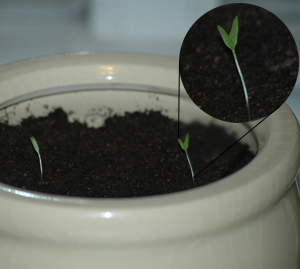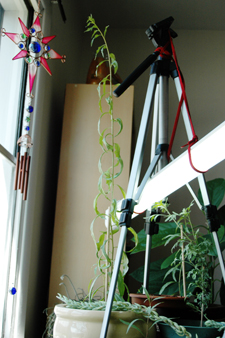Here’s an idea: instead of buying goji juice and goji berries, why not grow your own goji berries (and make your own juice if so inclined)? With very limited time and resources needed to get your own fresh, nutrient dense berries at a fraction of the cost, this is a fine alternative for those of us who are open to trying it.
Below you will find some basic information, but to really get the low down, sign up for my report above to get more visual, detailed, step by step information on how to grow goji berries and other super foods, including tips and tricks to get higher yields with less work.
What You Need to Grow Goji Berries
- Seeds (or plants if you have a source)
- Growing area (outdoors and/or in pots) with at least 6 hours of full sun (at least 8 is preferable)
- Organically rich, well drained soil
- Time (2-3 years before bearing)
Seeds
You can get seeds directly out of goji berries, but you can’t be sure what variety you are getting necessarily and if the berries are sun dried this may cause the seeds not to germinate properly.

These are goji plants I sprouted years ago, and some of them are now full fledged plants.
I have saved a large number of seeds from shade dried goji berries and although many of them did not germinate, it was not a big loss because each berry contains 20 to 30 seeds.
Where to Grow (To Pot or Not)
If you live in USDA growing zone 5 or warmer (doesn’t get colder than -15 F (-26 C)) you can grow the plants outdoor (although you might experiment in zone 4 in a very sunny and sheltered area). If you live in a colder area, skip to Growing Goji Berries in Pots below. You’ll need to prepare a place to plant them outside, which isn’t really that hard. Wherever there is free space, whether it be in your front yard (goji plants are quite beautiful and have wonderful purple flowers in the spring) or elsewhere. There are a few considerations for location. First, make sure you choose an area that has access to a lot of sun (south facing with no trees, buildings, etc. blocking the sun).
Also, try to choose a site that is chemical free (don’t use pesticides on the lawn where you are going to plant them or anywhere near them if possible). Keep your plants as far away from the road as possible as well, since pollution and dust from the road will contaminate them.
dust from the road will contaminate them.
If you are going to make a little patch to grow goji berries on your lawn, you may choose to just remove an area of grass (make a nice shape so your new goji garden looks nice). Make sure the soil is worked up and fork it to lessen the compaction, and if necessary, add some soil to the surface that is seed free. Alternatively, you can smother most of the grass for less work (instructions for this are in my growing guide newsletter which you can sign up for above or at the end of this page).
Plant the seeds after the last frost of the year, about half an inch down in the soil. Very lightly mulch around the seeds, making sure not to cover them (put the mulch where you didn’t put the seeds). Keep the soil consistently moist until germination, and then decrease watering, allowing the soil to get mostly dry before watering again. Water deeply to make sure the roots don’t stay close to the surface. Once they germinate, mulch at least 3 inches deep with wood chips or leaves.
Growing Goji Berries in Pots
If growing in pots, you can save money by getting creative here. If you can get access to a wooden barrel (half barrels are sold at some garden centers or hardware stores), cutting it in half would give you two nice, large, decorative pots that can be used to grow a few goji plants in. If you have the money, you can always just buy a few large pots too – at least 2 feet wide is best, if not larger (the bigger the better). You’ll probably need a few of them to get a decent amount of berries growing.
Soil
You’ll basically just need regular potting soil and some organic matter such as manure (a small amount, on top for slow release fertilizer). If you’re planting outside (recommended if climate is suitable), you’ll need to prepare a patch to grow the plants, as stated above. These soil tips apply to both outdoor growing and indoor:
Make sure your soil has good drainage, contains a lot of organic matter (if you can get a hold of some compost, vermiculite, rotted manure, or other organic matter, this would be very beneficial). Do NOT use chemical fertilizers such as Miracle Grow to grow goji berries as this disrupts the soil ecology and will only create more work for you. If you supply them with enough healthy, organic matter such as manure, they will not need chemical fertilizer.
Using chemical fertilizer to feed your plants is like forcing a human to live off of only a few of the basic chemicals needed to live, in liquid form, but not allowing them to eat solid foods like fruits and vegetables or whole grains to get the vitamins and minerals that are important for us to be healthy. Your berries will not contain the nutrients they are supposed to if you fertilize with chemicals as opposed to organic matter.
If growing in pots, you’ll also have to change out some of your soil every year or so, as the goji berry plants “eat” the existing nutrients. Luckily, plants get almost all of the matter that they produce their growth and fruit from directly from the air and sunlight, so you won’t need to add organic matter very often. If growing outside, make sure to work some manure, compost, vermiculite or other organic matter into the soil at least once every year or so.
Helpful Tricks: If you grow your plants outdoors with a diversity of other plants of the right kinds, you can prevent pests and disease and decrease the need for fertilizing. Plants need other plants to be healthy – that’s how they evolved. Again, learn more via my newsletter.
IMPORTANT: Goji berries like somewhat moist soil (although once established they are fairly drought tolerant as well). In natural settings, plants typically do NOT EVER have bear soil around them, so it is extremely important to mulch the planting beds of your goji plants, especially directly around the plants. This will drastically reduce water evaporation from soil and support a healthy soil ecosystem of worms and beneficial bacteria and fungus. Use wood chips, very well rotted hay, straw, leaf litter (but not oak or walnut leaves) or any other organic materials you can get your hands on. At least a couple of inches of mulch would be beneficial, and no more than four inches. It is best to use wood chips that are weathered and rotted a little, especially if you are dealing with cedar wood chips, since they are acidic and acidity is significantly reduced by weathering.
Water
Water the plants every day it doesn’t rain for at least the first 30 days if outdoors, and then during sustained droughts afterward. The soil should absorb water, but also have good drainage. If your potted plants are outside during the warm season in colder climates, make sure they do not get saturated with too much rain and that the excess water is able to drain from the pots. The plants will drown if they are soaked in water too long. It is important that you water the plants from the bottom; that is, try to avoid getting water on the leaves, since this will promote fungal disease. The best time to water in order to avoid fungal disease is in the early morning. If the plants are ever looking droopy, this means they need more water.
Sun
If your plants are inside, make sure they have access to at least 8 hours of direct sun. The more sun they get during the course of the day, the more berries they will produce and the more nutritious those berries will be.
If you can’t give them enough sun inside, you might consider putting a floresenct, full spectrum light over them for a few hours a day (perhaps turning the lights on when you wake up and turning them off when you go to bed). It is actually better to leave the light on 24/7 until the plants get a little bigger. If your plants are grown indoors away from direct sunlight, make sure to slowly “harden” the plants to exposure to the sun gradually, by placing them in the sun for only a few hours at a time at first before planting them outside permanently or even before just placing them outside in pots for the warm season.
A Little Lovin’ Goes a Long Way
Now all you need to do is sit back and watch your goji berries grow. It will take a couple of years to get good sized goji plants that produce a nice amount of berries, but at least when that time comes, you won’t be dependent on anyone else for your dose of polysaccharides and other beneficial agents and nutrients found in goji berries.
For a more thorough and visual step by step guide to growing goji berries and other superfoods, including basic and advanced gardening tips to cut back on work and increase yields, sign up to my Superfood Explorations newsletter.